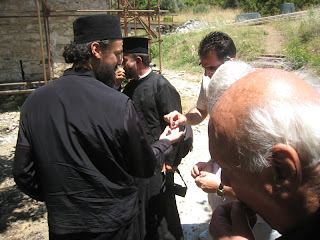On Wednesday morning, after the tour of Vatopaidi, we headed off to Simonopetra, where Bishop Maxim was welcomed with ringing bells by the abbot, Fr. Elisaios (above) and much of the brotherhood.
We were given a tour by the abbot, including the monastery's breathtaking view from the top (see above), as well as a tour of the library by Fr. Maximos, the Greek-American former Harvard professor who is now the monastery's librarian.
Finally, they gave us a wonderful lunch of octopus before we headed down to Daphni to catch a private speed boat back to Ouranoupolis.
Back in the world in Ouranoupolis, we met up with the five female pilgrims in the group and headed over to Kakovo, a Serbian men's monastery and dependency of Hilandar located only about 20 minutes away. There are only a handful of monks, but the property they are responsible for maintaining is enormous and full of crops, a lake for fishing, etc. It is dedicated to the Feast of the Life-Giving (or, better, Life-Receiving) Spring, which the Church celebrates on Bright Friday. Above is a photo of the courtyard where we visited with the monastery's abbot.
Above is a small chapel at the dependency.
We then headed on to a dependency of Simonopetra, the women's monastery of the Annunciation, located in the village of (and frequently referred to as) Ormylia. This is the largest monastery in Greece with about 120 nuns from approximately 17 or 18 different countries. Unfortunately, one member of our group was not feeling well, and one of the sisters at the monastery (who is also a doctor) recommended we take her to a hospital in Thessaloniki out of an abundance of caution. So Fr. Blasko and I took her to a private hospital near my house in Panorama. I then returned the next morning with Pelagia and the babies to visit with the abbess, Nikodemi, and the sisters after the Liturgy. When we walked in to the conversation between Bishop Maxim, the abbess, Fr. Serapion, a monk from Simonopetra who serves the monastery, and some of the nuns and pilgrims, Paul headed straight for Bishop Maxim and sat in his lap, eating the bishop's cookies (see above).
Later in the morning, Fr. Athanasios, a monk of Simonopetra and the chief hymnographer of the Great Church of Constantinople (the one responsible for composing all services to new saints, such as he has done for St. Silouan the Athonite and St. Justin of Celije), as well as the abbess' brother according to the flesh, came by to greet Bishop Maxim. Above and below are a couple photos of him playing with Paul. The babies loved being swung by him (see below).
Thus ended my participation in the pilgrimage, as the group continued on to Meteora and Bishop Maxim left for other obligations in Serbia. For more photos, click here and here.














































